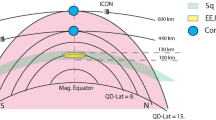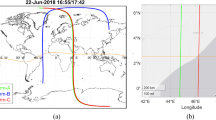Abstract
TOPEX/Poseidon, Jason-1, Jason-2 and Jason-3 altimeter missions have provided 27 + years of uninterrupted Total Electron Content (TEC) measurements since 1992, with unprecedented precision. Nevertheless, the issue of a possible systematic bias in the data was identified immediately after first TOPEX measurements were compared with measurements from other sources. The bias issue has remained open for decades, and it has increased in complexity because each new mission had its different bias. The purpose of this paper is to assess the problem of TEC bias of altimeters. Two approaches have been followed. The first one relied on the TEC data series of the four altimeters to determine inter-mission systematic biases using the last available data versions for each mission. The second approach consisted of inspecting the missions’ official reports to trace changes of the inter-mission and inter-version biases, including biases relative to DORIS ionospheric measurements. Both approaches have converged and resulted in the determination of a reference frame where missions, instruments and ionospheric reference levels could be compared. This reference frame was also used to analyze results published in representative papers during the last decades, including ionospheric data from the ENVISAT mission. This reference frame could help to assess TEC levels of the announced new data version of Jason-2, Jason-3 and the imminent Jason-CS/Sentinel missions. The main conclusion of this work is that Jason-1, ‘E’ data version, defines a TEC reference level which is compatible with most of the results found in the literature.
Highlights
-
This contribution provides evidence in favor of TEC data series from Jason-1, ‘E’ version, as the most accurate reference level among altimeter missions and versions.
-
This work tries to assess a long-lasting issue about the existence of systematic biases among ionospheric data series obtained from different satellite altimeters.
-
This work establishes a TEC reference frame where it is possible to ‘map’ already published results and interpret their meanings.
-
This work provides a frame where any possible bias in the upcoming ‘F’ data version series of Jason-2 and Jason-3, and of the imminent Jason-CS/Sentinel-6A mission could be detected.








Similar content being viewed by others
Data availability
TOPEX/Poseidon and Jason 1 datasets analyzed for the current study are available at https://openadb.dgfi.tum.de/en/data_access/. Jason 2 and Jason3 datasets analyzed during the current study are available at ftp://ftp.nodc.noaa.gov/pub/data.nodc/.
The missions’ reports used in this work are available at https://www.aviso.altimetry.fr/en/data/calval/systematic-calval.html.
Availability of data and material
Not applicable.
Code availability
Not applicable.
References
Ablain M, Philipps S (2006) TOPEX/Poseidon validation activities-13 years of T/P data (GDR-Ms). SALP-RP-MA-EA-21315-CLS, 1rev1
Ablain M, Philipps S (2007) Jason-1 validation and cross calibration activities. SALP-RP-MA-EA-21377-CLS, 1rev1
Azpilicueta F, Brunini C (2009) Analysis of the bias between TOPEX and GPS vTEC determinations. J Geod. https://doi.org/10.1007/s00190-008-0244-7
Azpilicueta F, Nava B (2021) Studying the winter anomaly with altimeter-derived TEC data. Adv Space Res. https://doi.org/10.1016/j.asr.2021.06.008
Blanck F, Schgounn C et al (1996) AVISO/Altimetry 1996. AVISO user handbook for merged TOPEX/POSEIDON products, AVI-NT-02-101, 3.0
Chen P, Liu H, Ma Y, Zheng N (2019) Accuracy and consistency of different global ionospheric maps released by IGS ionosphere associate analysis centers. Adv Space Res. https://doi.org/10.1016/j.asr.2019.09.042
Chen J, Ren X, Zhang X et al (2020) Assessment and validation of three ionospheric models (IRI-2016, NeQuick2, and IGS-GIM) from 2002 to 2018. Space Weather. https://doi.org/10.1029/2019SW002422
Codrescu MV, Beierle KL et al (2001) More total electron content climatology from TOPEX/Poseidon measurements. Rad Sci. https://doi.org/10.1029/1999RS002407
Commien L, Philipps S, Ablain M (2009) Jason-1 validation and cross calibration Activities. SALP-RP-MA-EA-21631-CLS, 1rev 1
Dumont JP, Rosmorduc V et al (2017a) OSTM/Jason-2 Products Handbook. CNES: SALP-MU-M-OP-15815-CN, EUMETSAT: EUM/OPS-JAS/MAN/08/0041, JPL: OSTM-29-1237, NOAA/NESDIS: Polar Series/OSTM J400, Issue: 1 rev 11
Dumont JP, Rosmorduc V et al (2017b) Jason-3 Products Handbook. CNES: SALP-MU-M-OP-16118-CN, Issue 1 rev 4
Faugere T, Mertz Y, Dorandeu J (2004) Envisat RA2/MWR ocean data validation and crosscalibration activities. Yearly report, SALP-RP-MA-EA-21234-CLS, 1rev 1
Hernández-Pajares M, Juan JM et al (2008) The IGS VTEC maps: a reliable source of ionospheric information since. J Geod. https://doi.org/10.1007/s00190-008-0266-1
Iijima BA, Harris IL et al (1999) Automated daily process for global ionospheric total electron content maps and satellite ocean altimeter ionospheric calibration based on Global Positioning System data. J Atmos Sol-Terr Phys. https://doi.org/10.1016/S1364-6826(99)00067-X
Imel DA (1994) Evaluation of the TOPEX/POSEIDON dual-frequency ionosphere correction. J Geophys Res. https://doi.org/10.1029/94JC01869
Johnston G, Riddell A, Hausler G (2017) The international GNSS service. In: Teunissen PJG, Montenbruck O (eds) Springer handbook of global navigation satellite systems, 1st edn. Springer, Cham, pp 967–982
Mannucci A, Wilson B et al (1994) A new method for monitoring the Earth’s ionospheric Total Electron Content using the GPS global network. In: Proceedings of ION-GPS 93. Salt Palace Convention Center, Salt Lake City, UT, pp 1323–1332
Ollivier A, Guibbaud M (2012) Envisat RA2/MWR reprocessing impact on ocean data. SALP-RP-MA-EA-22083-CLS, 1rev 0
Ollivier A, Jettou G (2017) Envisat RA2/MWR V3.0 reprocessing impact on ocean data. SALP-RP-MA-EA-23171-CLS, 1rev 2, December 2017.
Phillipps S, Ablain M, Valladeau G, Legeais J-F (2012) Jason-2 validation and cross-calibration activities (Annual report 2011). SALP-RP-MA-EA-22042-CLS
Picot N, Desai S et al (2016) Jason-1 Products Handbook, CNES: SALP-MU-M5-OP-13184-CN; JPL: JPL D-21352; Issue: 5 rev 1
Roinard H, Lievin M (2017a) Jason-2 validation and cross-calibration activities (Annual report 2016). SALP-RP-MA-EA-23058-CLS, 1rev 2
Roinard H, Philipps S (2017b) Jason-1 - GDR-E release - Global assessment over ocean. SALP RP-MA-EA-22426-CLS, 1rev1
Roinard H, Valladeau G, Legais JF, Phillips S, Ablain M (2014) Jason-1 validation and cross calibration activities [Annual Report 2013]. SALP-RP-MA-EA-22269-CLS, 1rev 1
Roinard H, Laurent O, Philipps S (2016) Jason-2 validation and cross-calibration activities (Annual report 2015). SALP-RP-MA-EA-22961-CLS
Roinard H, Michaud L (2020) Jason-3 validation and cross calibration activities (Annual report 2019). SALP-RP-MA-EA-23399-CLS, Issue 1.1
Ruffini G, Cardellach E et al (1998) Ionospheric calibration of radar altimeters using GPS tomography. Geophys Res Lett. https://doi.org/10.1029/1998GL900004
Schaer S (1999) Mapping and predicting the Earth’s ionosphere using the Global Positioning System, Geodaetisch–geophysikalische Arbeiten in der Schweiz, 59, Ph.D. Thesis, Bern University
Zhao C, Shum CK et al (2004) Accuracy assessment of TOPEX/poseidon ionosphere measurements. Mar Geodesy. https://doi.org/10.1080/01490410490889076
Acknowledgements
The authors thank A. Cuestas and E. Scorians from the English Department of FCAG for the revision of the English language.
Funding
Not applicable.
Author information
Authors and Affiliations
Contributions
F. Azpilicueta has contributed by developing the ideas presented in the manuscript, computing the results and writing the manuscript. B. Nava has contributed with conceptual discussions, by cross-validating the results and editing the text of the manuscript.
Corresponding author
Ethics declarations
Conflict of interest
Not applicable.
Supplementary Information
Below is the link to the electronic supplementary material.
Rights and permissions
About this article
Cite this article
Azpilicueta, F., Nava, B. On the TEC bias of altimeter satellites. J Geod 95, 114 (2021). https://doi.org/10.1007/s00190-021-01564-y
Received:
Accepted:
Published:
DOI: https://doi.org/10.1007/s00190-021-01564-y




